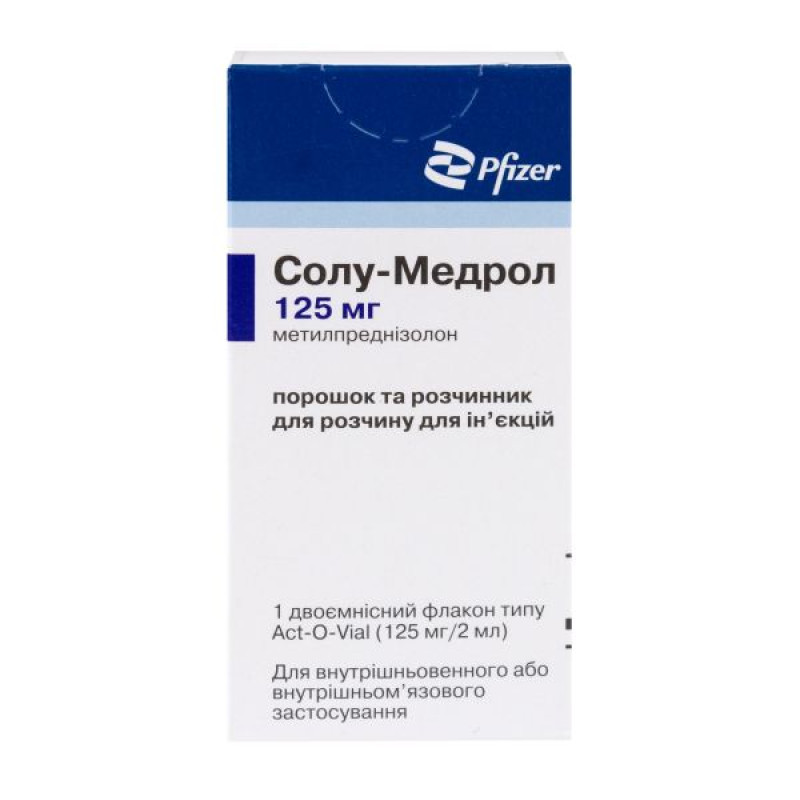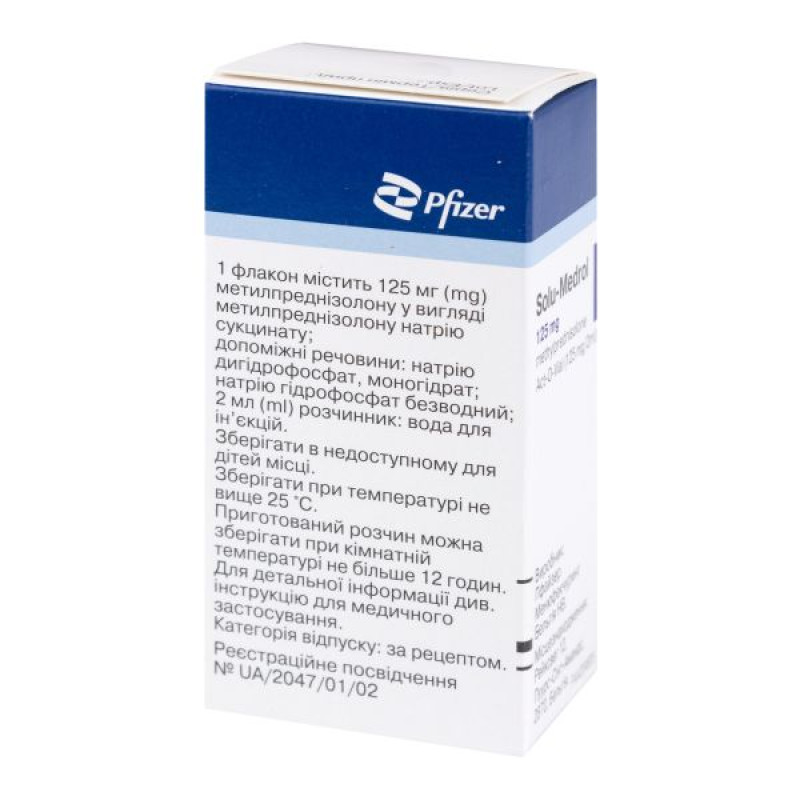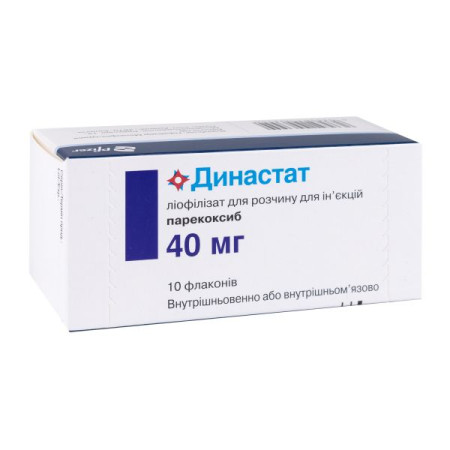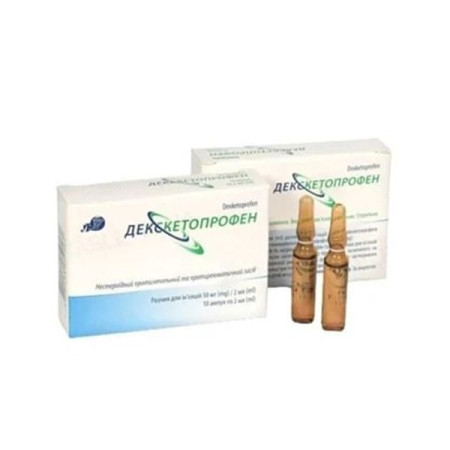Solu-Medrol powder and solvent for solution for injection 125 mg/2 ml Act-O-Vial No. 1
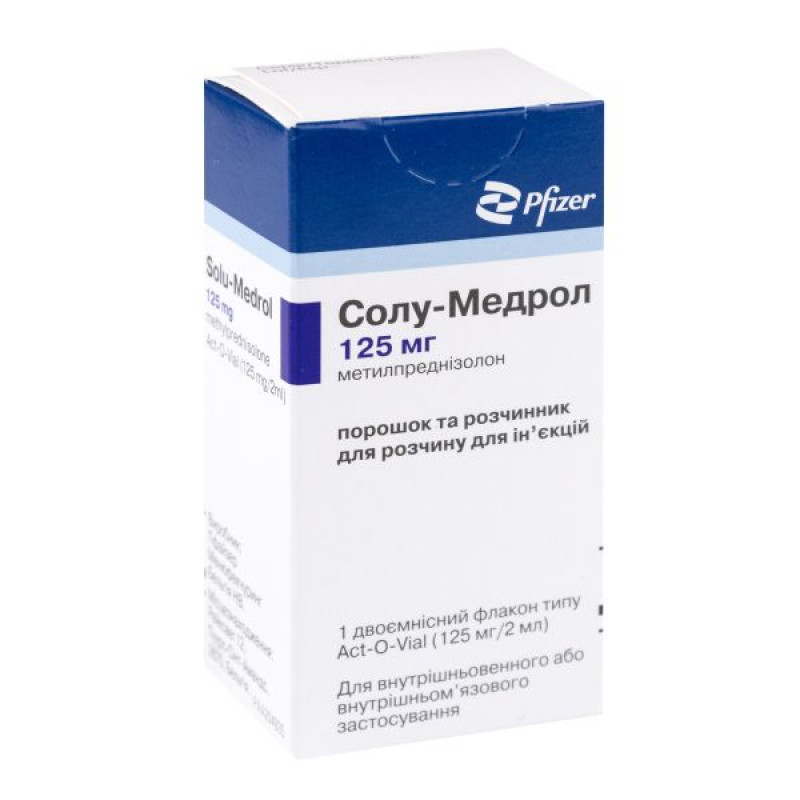
Instructions for Solu-Medrol powder and solvent for solution for injection 125 mg/2 ml Act-O-Vial No. 1 vial
Composition
active ingredient: methylprednisolone;
1 vial contains 40 mg or 125 mg, or 500 mg, or 1000 mg of methylprednisolone in the form of methylprednisolone sodium succinate;
excipients: for dosages of 125 mg or 500 mg, or 1000 mg - sodium dihydrogen phosphate, monohydrate; sodium hydrogen phosphate anhydrous;
excipients: for dosage 40 mg - sodium dihydrogen phosphate, monohydrate; sodium hydrogen phosphate anhydrous; sucrose;
solvent for dosage 40 mg and 125 mg: water for injections;
solvent for dosage of 500 mg and 1000 mg: benzyl alcohol (9 mg/ml), water for injections.
Dosage form
Powder and solvent for solution for injection.
Main physicochemical properties:
powder: white to almost white lyophilisate;
solvent for 40 mg and 125 mg dosage: clear, colorless solution;
solvent for 500 mg and 1000 mg dosage: clear colorless liquid with a slight odor of benzyl alcohol.
Pharmacotherapeutic group
Corticosteroids for systemic use.
ATX code H02A B04.
Pharmacological properties
This medicine is an injectable form of methylprednisolone (a synthetic glucocorticosteroid) for intramuscular and intravenous administration. This highly concentrated solution is suitable, in particular, for the treatment of pathological conditions in which an effective and rapid effect of the hormone is required. Methylprednisolone has a strong anti-inflammatory, immunosuppressive and antiallergic effect.
Pharmacodynamics
Glucocorticoids penetrate the cell membrane by diffusion and form complexes with specific receptors in the cytoplasm. These complexes then enter the cell nucleus, bind to DNA (chromatin) and stimulate mRNA transcription and subsequent synthesis by various enzymes of proteins, which, in turn, are responsible for the numerous effects of glucocorticoids after systemic administration. Glucocorticoids not only exert a significant effect on inflammatory and immune processes, but also affect the metabolism of carbohydrates, proteins and fats. They also act on the cardiovascular system, skeletal muscles and the central nervous system.
Impact on inflammatory and immune processes.
The anti-inflammatory, immunosuppressive, and antiallergic properties of glucocorticoids are used in most therapeutic indications. The presence of these properties leads to the following results:
reduction in the number of immunoactive cells around the focus of inflammation;
reduced vasodilation;
stabilization of lysosomal membranes;
inhibition of phagocytosis;
reducing the formation of prostaglandins and related substances.
A dose of 4 mg of methylprednisolone exhibits the same glucocorticosteroid (anti-inflammatory) effect as 20 mg of hydrocortisone. Methylprednisolone exhibits only minimal mineralocorticoid effect (200 mg of methylprednisolone corresponds to 1 mg of deoxycorticosterone).
Effect on carbohydrate and protein metabolism.
Glucocorticoids have a catabolic effect on protein metabolism. The released amino acids are converted into glucose and glycogen in the liver by the process of gluconeogenesis. Thus, glucose absorption by peripheral tissues is reduced, which can lead to hyperglycemia and glycosuria, especially in patients with a predisposition to diabetes.
Effect on fat metabolism.
Glucocorticoids have a lipolytic effect, which mainly affects the extremities. They also have a lipogenetic effect, which is most pronounced in the chest, neck and head. All this leads to the redistribution of fat deposits.
The maximal pharmacological action of corticosteroids lags behind the achievement of their peak blood concentrations, indicating that most of the effects of these drugs are more likely the result of modification of enzyme activity rather than direct action of these agents.
Pharmacokinetics.
The pharmacokinetics of methylprednisolone are linear regardless of the route of administration.
Absorption
Intravenous infusion of the drug at a dose of 30 mg/kg of body weight when administered over 20 minutes or at a dose of 1 g when administered over 30–60 minutes after approximately 15 minutes leads to a peak concentration of methylprednisolone in the blood plasma of about 20 mg/ml. Approximately 25 minutes after an intravenous bolus injection of the drug at a dose of 40 mg, the peak concentration of methylprednisolone in the blood plasma is 42–47 mg/100 ml. Approximately 120 minutes after an intramuscular injection of the drug at a dose of 40 mg, the peak concentration of methylprednisolone in the blood plasma is 34 mg/100 ml. With intramuscular injection, the peak value is lower than with intravenous injection. When administered intramuscularly, plasma concentrations are maintained for a longer period, resulting in an equivalent amount of methylprednisolone being delivered by both routes. The clinical significance of these minor differences is probably minimal given the mechanism of action of glucocorticoids. Clinical response is usually observed 4–6 hours after administration. In the treatment of bronchial asthma, the first beneficial effects may be seen within 1–2 hours. The plasma half-life of methylprednisolone sodium succinate is 2.3–4 hours and is probably independent of the route of administration.
Methylprednisolone is a medium-acting glucocorticoid. Its biological half-life is 12–36 hours. The intracellular activity of glucocorticoids is reflected by a clear difference between the plasma half-life and the pharmacological half-life. Pharmacological activity persists after the plasma level of the drug is no longer detectable. The duration of anti-inflammatory activity of glucocorticoids is approximately equal to the duration of suppression of the hypothalamic-pituitary-adrenal (HPA) axis. After intravenous administration of 14C-labeled methylprednisolone, 75% of the total radioactivity is recovered in the urine within 96 hours, 9% in the feces after 5 days, and 20% in the bile.
Distribution
Methylprednisolone is widely distributed in tissues, crosses the blood-brain barrier and is excreted in breast milk. The apparent volume of distribution is approximately 1.4 l/kg. The binding of methylprednisolone to plasma proteins in humans is approximately 77%.
Biotransformation
The hepatic metabolism of methylprednisolone is qualitatively similar to that of cortisol. The metabolites are mainly excreted in the urine as glucuronides, sulfates, and unconjugated compounds.
In humans, methylprednisolone is metabolized in the liver to inactive metabolites, the main of which are 20α-hydroxymethylprednisolone and 20β-hydroxymethylprednisolone.
Metabolism in the liver occurs mainly with the participation of the CYP3A4 enzyme (for a list of drug interactions due to CYP3A4-mediated metabolism, see the section "Interaction with other medicinal products and other types of interactions")
Methylprednisolone, like many other CYP3A4 substrates, can also be a substrate for p-glycoprotein, a transport protein of the ATP-binding cassette (ABC) transporter family, which affects its distribution in tissues and interactions with other drugs.
Breeding
The mean elimination half-life of total methylprednisolone is 1.8 to 5.2 hours. Total clearance is approximately 5–6 mL/min/kg.
Special patient groups
Sex
After a single intravenous dose, methylprednisolone clearance was higher in healthy women than in healthy men: 0.45 L/h/kg compared with 0.29 L/h/kg. However, no differences in pharmacodynamic parameters were observed.
Elderly patients
After a single intravenous dose, the clearance of methylprednisolone in healthy elderly men (69–82 years) was lower than in younger men (24–37 years): 0.24 L/h/kg compared with 0.36 L/h/kg.
Children
Methylprednisolone clearance is slightly related to age. Methylprednisolone metabolism is generally faster in younger patients. In a single-dose intravenous study in 14 patients with nephrotic syndrome, younger patients (< 13 years) had higher clearance than older patients (> 13 years): 0.53 L/h/kg compared with 0.38 L/h/kg.
Kidney dysfunction
In a single-dose intravenous study in 6 male patients with chronic renal failure, the pharmacokinetics of methylprednisolone were unchanged compared to the pharmacokinetics in a control group of healthy volunteers with a mean clearance of 0.28 L/h/kg. In addition, no differences in pharmacodynamic parameters were observed in these patients with chronic renal failure.
Liver dysfunction
In a single-dose intravenous study in 6 male patients with chronic hepatic insufficiency, the pharmacokinetics of methylprednisolone were similar to those in a control group of healthy volunteers with a mean clearance of 0.29 L/h/kg.
Indication
The use of glucocorticoids should be considered only as an exclusively symptomatic treatment, except for certain endocrine disorders, when they are used as replacement therapy.
Anti-inflammatory treatment.
As adjunctive therapy for short-term use (to help the patient survive an acute episode or exacerbation) in the following diseases:
post-traumatic osteoarthritis;
synovitis in osteoarthritis;
rheumatoid arthritis, in particular juvenile rheumatoid arthritis (in some cases, low-dose maintenance therapy may be required);
acute and subacute bursitis;
epicondylitis;
acute nonspecific tendosynovitis;
acute gouty arthritis;
psoriatic arthritis;
ankylosing spondylitis.
Collagenoses (systemic connective tissue diseases).
During exacerbation or as maintenance therapy in some cases for diseases such as:
systemic lupus erythematosus (and lupus nephritis);
acute rheumatic carditis;
systemic dermatomyositis (polymyositis);
periarteritis nodosa;
Goodpasture's syndrome.
Dermatological diseases:
pemphigus;
severe erythema multiforme (Stevens–Johnson syndrome);
exfoliative dermatitis;
bullous dermatitis herpetiformis;
severe seborrheic dermatitis;
severe psoriasis;
fungal mycosis;
hives.
Allergic conditions.
Control of severe or disabling allergic conditions that do not respond to adequate conventional treatment, in diseases such as:
bronchial asthma;
contact dermatitis;
atopic dermatitis;
serum sickness;
hypersensitivity reactions to drugs;
hives;
acute non-infectious laryngeal edema (epinephrine is the drug of first choice).
Ophthalmological diseases.
Severe acute and chronic allergic and inflammatory processes in the eye area, including:
ocular form of Herpes zoster;
iritis, iridocyclitis;
chorioretinitis;
diffuse posterior uveitis and choroiditis;
optic neuritis;
sympathetic ophthalmia;
inflammation of the middle segment of the eye;
allergic conjunctivitis;
allergic ulcers of the corneal edge;
keratitis.
Gastrointestinal tract diseases.
Critical periods for the following diseases:
ulcerative colitis (systemic therapy);
regional enteritis (systemic therapy).
Respiratory diseases:
pulmonary sarcoidosis;
berylliosis;
fulminant or disseminated pulmonary tuberculosis when used concomitantly with appropriate anti-tuberculosis chemotherapy;
Leffler syndrome, which is not treatable by other means;
aspiration pneumonitis;
moderate and severe pneumonia caused by Pneumocystis carinii in patients with AIDS (as adjunctive therapy during the first 72 hours of anti-Pneumocystis therapy);
exacerbation of chronic obstructive pulmonary disease.
Conditions accompanied by edema.
To induce diuresis or remission in proteinuria in nephrotic syndrome, proteinuria without uremia.
Immunosuppressive treatment.
Organ transplantation.
Treatment of hematological and oncological diseases.
Hematological diseases:
acquired (autoimmune) hemolytic anemia;
idiopathic thrombocytopenic purpura in adults (intravenous only, intramuscular use is contraindicated);
secondary thrombocytopenia in adults;
erythroblastopenia (erythrocytic anemia);
congenital (erythroid) hypoplastic anemia;
Oncological diseases.
Palliative treatment of diseases such as:
leukemia and lymphoma in adults;
acute leukemia in children;
to improve the quality of life of patients with terminal cancer.
Others.
Nervous system.
Cerebral edema due to primary or metastatic tumor and/or adjuvant treatment during surgery or radiation therapy.
Exacerbation of multiple sclerosis.
Acute spinal cord injury. Treatment should begin within the first eight hours after the injury.
Tuberculous meningitis with subarachnoid space blockade or threat of blockade with concomitant use of appropriate anti-tuberculosis chemotherapy.
Trichinosis with damage to the nervous system or myocardium.
Prevention of nausea and vomiting associated with chemotherapy for malignant neoplasms.
Endocrine disorders.
Primary or secondary adrenal insufficiency.
Acute adrenal insufficiency.
In these indications, the drugs of choice are hydrocortisone or cortisone. In certain circumstances, synthetic analogues can be used in combination with mineralocorticoids.
Treatment of shock: shock due to adrenal insufficiency or shock unresponsive to conventional treatment, in cases of confirmed or suspected adrenal insufficiency (hydrocortisone is generally the drug of choice). If mineralocorticoid effects are undesirable, methylprednisolone may be preferred.
Before surgery and in case of severe trauma or illness in patients with established adrenal insufficiency, or if there is doubt about adrenal reserve.
Congenital adrenal hyperplasia.
Non-purulent thyroiditis.
Hypercalcemia associated with malignancy.
Contraindication
Systemic fungal infections.
Hypersensitivity to methylprednisolone or to any of the excipients listed in the "Composition" section.
Intrathecal administration.
Epidural injection.
Interaction with other medicinal products and other types of interactions
Methylprednisolone is a substrate of cytochrome P450 (CYP) and is primarily metabolized by the enzyme CYP3A4. CYP3A4 is the major enzyme of the most abundant CYP subfamily in the liver of adult humans. It catalyzes 6β-hydroxylation of steroids, which is a key step in phase I metabolism for both endogenous and synthetic corticosteroids. Many other compounds are also substrates of CYP3A4, some of which (along with other drugs) have been shown to alter glucocorticoid metabolism by inducing (increasing activity) or inhibiting the enzyme CYP3A4.
CYP3A4 INHIBITORS: Drugs that inhibit CYP3A4 activity tend to decrease hepatic clearance and increase plasma concentrations of drugs that are CYP3A4 substrates, such as methylprednisolone. Therefore, methylprednisolone doses should be titrated to avoid steroid toxicity.
CYP3A4 INDUCERS: Drugs that induce CYP3A4 activity generally increase hepatic clearance, resulting in decreased plasma concentrations of drugs that are CYP3A4 substrates. When these drugs are used concomitantly, an increase in the dose of methylprednisolone may be required to achieve the desired effect.
CYP3A4 SUBSTRATES: The presence of another CYP3A4 substrate may affect the hepatic clearance of methylprednisolone, and appropriate dose adjustment may be necessary. It is possible that the likelihood of adverse events associated with each of these drugs alone is increased when they are used concomitantly.
EFFECTS NOT MEDIATED BY CYP3A4: Other interactions and effects observed with methylprednisolone are described in the table below.
The table presents a list and description of the most frequent and/or clinically important interactions or results of interactions of methylprednisolone with other drugs.
Important interactions/effects when using methylprednisolone with other drugs or substances
Class or type of drug MEDICINE or SUBSTANCE | Interaction/effect |
|---|---|
Antibacterial agents ISONIAZIDE | CYP3A4 INHIBITOR. In addition, a potential effect of methylprednisolone is to increase the level of acetylation and clearance of isoniazid. |
Antibiotics, anti-tuberculosis drugs RIFAMPINE | CYP3A4 INDUCTOR |
| Anticoagulants (for oral use) | The effect of methylprednisolone on oral anticoagulants is variable. Both potentiation and attenuation of anticoagulant effects have been reported when given concomitantly with corticosteroids. Therefore, coagulation parameters should be monitored to maintain the desired anticoagulant effect. |
Anticonvulsants CARBAMAZEPIN | CYP3A4 INDUCTOR (and SUBSTRATE) |
Anticonvulsants PHENOBARBITAL PHENYTOIN | CYP3A4 INDUCTORS |
Anticholinergic drugs NEUROMUSCULAR BLOCKERS | Corticosteroids may interfere with the effects of anticholinergic drugs. Cases of acute myopathy have been reported with concomitant use of high doses of corticosteroids and anticholinergics, particularly neuromuscular blocking agents (for more information, see section 4.4: Musculoskeletal disorders). Antagonism of the neuromuscular blocking effects of pancuronium and vecuronium has been reported in patients receiving corticosteroids. This type of interaction is possible with all competitive neuromuscular blocking agents. |
| Anticholinesterase agents | Steroids may weaken the effects of anticholinesterase agents in patients with myasthenia gravis. |
| Antidiabetic drugs | Since corticosteroids may increase blood glucose concentrations, dose adjustment of antidiabetic drugs may be required. |
Antiemetics APREPITANT FOSAPREPITANT | CYP3A4 INHIBITORS (and SUBSTRATES) |
Antifungal agents ITRACONAZOLE KETOCONAZOLE | CYP3A4 INHIBITORS (and SUBSTRATES) |
Antivirals HIV PROTEASE INHIBITORS | CYP3A4 INHIBITORS (and SUBSTRATES) Protease inhibitors, including indinavir and ritonavir, may increase plasma concentrations of corticosteroids. Corticosteroids may induce the metabolism of HIV protease inhibitors and thus reduce their plasma concentrations. |
| Pharmacokinetic enhancers - COBICYSTAT | CYP3A4 INHIBITORS Pharmacokinetic enhancers inhibit CYP3A4 activity, resulting in decreased hepatic clearance and increased plasma concentrations of corticosteroids. Corticosteroid dose adjustment may be required (see section 4.4). |
Aromatase inhibitors AMINOGLUTETHIMIDE | Suppression of adrenal function caused by aminoglutethimide may lead to increased endocrine changes caused by prolonged use of glucocorticoids. |
Calcium channel blockers DILTIAZEM | CYP3A4 INHIBITOR (and SUBSTRATE) |
Contraceptives (oral) ETHINYLESTRADIOL/ NORETHISTERONE | CYP3A4 INHIBITOR (and SUBSTRATE) |
| GRAPEFRUIT JUICE | CYP3A4 INHIBITOR |
Immunosuppressants CYCLOSPORINE | CYP3A4 INHIBITOR (and SUBSTRATE) When cyclosporine and methylprednisolone are used together, there is mutual inhibition of metabolism, which may lead to increased plasma concentrations of one or both of these drugs. It is possible that concomitant use may increase the likelihood of side effects associated with the use of each individual drug. Convulsions have been reported with the concomitant use of methylprednisolone and cyclosporine. |
Immunosuppressants CYCLOPHOSPHAMIDE TACROLIMUS | CYP3A4 SUBSTRATES |
Macrolide antibiotics CLARITHROMYCIN ERYTHROMYCIN | CYP3A4 INHIBITORS (and SUBSTRATES) |
Macrolide antibiotics TROLEANDOMYCIN | CYP3A4 INHIBITOR |
NSAIDs (nonsteroidal anti-inflammatory drugs) acetylsalicylic acid in high doses | The incidence of gastrointestinal bleeding and ulcers may be increased when corticosteroids and NSAIDs are used concomitantly. Methylprednisolone may increase the clearance of high doses of acetylsalicylic acid, which may lead to a decrease in serum salicylate levels. Discontinuation of methylprednisolone therapy may cause an increase in serum salicylate levels, which may lead to an increased risk of salicylate toxicity. Acetylsalicylic acid should be used with caution in combination with corticosteroids in the case of hypoprothrombinemia. |
| Potassium-depleting agents | In the case of concomitant use of corticosteroids with potassium-sparing agents (i.e. diuretics), the patient should be closely monitored for the possible development of hypokalemia. The use of glucocorticoids in combination with thiazide diuretics increases the risk of glucose intolerance. The risk of hypokalemia is also increased when corticosteroids are used concomitantly with amphotericin B, xanthenes, or beta2-agonists. |
Incompatibility
To avoid compatibility and stability problems, it is recommended that methylprednisolone sodium succinate be administered separately from other compounds administered intravenously. Drugs that are physically incompatible with methylprednisolone sodium succinate in solution include (but are not limited to): allopurinol sodium, doxapram hydrochloride, tigecycline, diltiazem hydrochloride, calcium gluconate, vecuronium bromide, rocuronium bromide, cisatracurium besylate, glycopyrrolate, propofol.
DESIRED INTERACTIONS
In the treatment of neoplastic diseases, such as leukemia and lymphoma, methylprednisolone is usually used in combination with alkylating agents, antimetabolites, and vinca alkaloids.
Application features
Immunosuppressive effects/increased susceptibility to infections.
Glucocorticosteroids may increase susceptibility to infections, mask some signs of infection, and may cause new infections during their use. Corticosteroids may reduce the body's resistance and ability to localize infection. The use of corticosteroids alone or in combination with other immunosuppressive agents that affect cellular, humoral immunity, or neutrophil function may be associated with the development of infections caused by any pathogen, including viruses, bacteria, fungi, protozoa, and helminths, in any part of the body. These infections may be mild in severity, but they can be severe and sometimes fatal. The incidence of infections increases with increasing doses of corticosteroids.
Patients taking immunosuppressive drugs are more vulnerable to infections than healthy people. For example, chickenpox and measles can be more serious or even fatal in immunocompromised children or in adults taking corticosteroids.
Administration of live or live-attenuated vaccines is contraindicated in patients receiving immunosuppressive doses of corticosteroids. Killed or inactivated vaccines, as well as biogenetic vaccines, may be administered to such patients; however, the response to such vaccines may be reduced or they may even be ineffective. Any necessary immunization procedures may be performed in patients receiving non-immunosuppressive doses of corticosteroids.
In active tuberculosis, the use of corticosteroids should be limited to cases of fulminant or disseminated tuberculosis and should be initiated concurrently with an appropriate course of antituberculosis therapy. If corticosteroids are indicated in patients with latent tuberculosis or tuberculin reactivity, these patients should be carefully monitored because of the possibility of reactivation of the disease. During long-term corticosteroid therapy, these patients should receive chemoprophylaxis.
Kaposi's syndrome has been reported in patients receiving corticosteroid therapy. Discontinuation of corticosteroid therapy may result in clinical remission.
The role of corticosteroids in the development of septic shock is controversial. Early studies reported both beneficial and harmful effects. It was later hypothesized that adjunctive corticosteroids would be beneficial in patients with confirmed septic shock who have adrenal insufficiency. However, their routine use in septic shock is not recommended. One systematic review of short-course, high-dose corticosteroids found no evidence to support their use. However, meta-analyses and one review of published data suggest that longer courses (5–11 days) of low-dose corticosteroids may reduce mortality, particularly in patients with septic shock who require vasopressor therapy.
Impact on the immune system.
Allergic reactions may occur. Since cutaneous and anaphylactic/anaphylactoid reactions are rare in patients receiving parenteral corticosteroid therapy, appropriate precautions should be taken before using the drug, especially if the patient has a history of allergy to any drug.
Impact on the endocrine system.
Patients who are exposed to unusual stress while on corticosteroid therapy may require increased doses of short-acting corticosteroids before, during, and after the stressful event.
Prolonged use of pharmacological doses of glucocorticoids may lead to suppression of the hypothalamic-pituitary-adrenal axis (secondary adrenocortical insufficiency). The degree and duration of adrenocortical insufficiency vary among patients and depend on the dose, frequency, timing of administration, and duration of glucocorticoid therapy. This effect can be minimized by using an alternate-day dosing schedule.
In addition, in the event of abrupt cessation of glucocorticoid therapy, acute adrenal insufficiency with fatal outcome is possible.
Secondary adrenal insufficiency caused by the drug can be minimized by gradually reducing the dose. This type of relative insufficiency can persist for several months after discontinuation of therapy; therefore, in any stressful situation that occurs during this period, hormone therapy should be resumed.
Also, after abrupt cessation of glucocorticoid therapy, a steroid withdrawal syndrome, apparently unrelated to adrenal insufficiency, may occur. This syndrome includes the following symptoms: anorexia, nausea, vomiting, lethargy, headache, fever, joint pain, skin peeling, myalgia, weight loss, and/or hypotension. These effects are believed to be caused by the abrupt change in glucocorticoid concentration rather than by low corticosteroid levels.
Since glucocorticoids may induce or exacerbate Cushing's syndrome, their use should be avoided in patients with this syndrome.
Corticosteroids have an enhanced effect on patients with hypothyroidism.
Metabolic and nutritional disorders.
Corticosteroids, particularly methylprednisolone, may increase blood glucose levels, worsen the condition of diabetic patients, and increase the susceptibility of patients receiving long-term corticosteroid therapy to diabetes mellitus. Such patients should be treated under close medical supervision and for the shortest possible period of time.
Mental disorders.
Psychiatric disorders may occur during corticosteroid therapy, ranging from euphoric mood, insomnia, mood swings, personality changes, and severe depression to overt psychotic manifestations. Corticosteroids may also exacerbate pre-existing emotional instability or psychotic tendencies.
Potentially serious psychiatric adverse reactions may occur with systemic steroids. Symptoms usually appear within a few days or weeks of initiating therapy. Most reactions resolve after dose reduction or discontinuation of therapy, although specific treatment may be necessary. Psychological effects have been reported after discontinuation of corticosteroids; frequency unknown. Patients and caregivers should be encouraged to seek medical attention if the patient develops psychological symptoms, especially if depression or suicidal ideation is suspected. Patients/caregivers should be aware of the possibility of psychiatric disorders that may develop during or shortly after dose reduction or discontinuation of systemic steroids.
Nervous system disorders.
Corticosteroids should be used with caution in patients with myasthenia gravis.
Although controlled clinical trials have demonstrated the efficacy of corticosteroids in accelerating the resolution of acute episodes of multiple sclerosis, they do not suggest that corticosteroids affect the final outcome or natural history of the disease. However, studies have shown that relatively high doses of corticosteroids are required to produce a significant effect.
Serious medical events have been reported in association with the intrathecal and epidural routes of administration (see section 4.8).
Cases of epidural lipomatosis have been reported in patients receiving corticosteroids, usually with prolonged use at high doses.
Disorders of the organs of vision.
Corticosteroids should be used with caution in patients with ocular herpes simplex due to the possibility of corneal perforation.
Prolonged use of corticosteroids may result in posterior subcapsular cataracts and nuclear cataracts (especially in children), exophthalmos, or increased intraocular pressure, which may cause glaucoma with possible damage to the optic nerves. Corticosteroids may also promote the development of secondary fungal or viral infections of the eye.
Visual impairment is possible with the use of topical and systemic corticosteroids. If symptoms such as blurred vision or other visual disturbances are observed, the patient should be referred to an ophthalmologist for consultation to identify possible causes, which may include cataracts, glaucoma, or rare diseases, including central serous chorioretinopathy, which have been reported with systemic or local use of corticosteroids.
Corticosteroid therapy has been associated with central serous chorioretinopathy, which can lead to retinal detachment.
Heart disorders.
The cardiovascular side effects of glucocorticoids, including dyslipidemia and hypertension, may predispose patients receiving the drug and having other cardiovascular risk factors to additional cardiovascular effects with prolonged high-dose therapy. Accordingly, corticosteroids should be used with caution in such patients. Changes in risk should be noted and additional cardiac monitoring should be performed as necessary. The use of low doses and alternate-day dosing may reduce the incidence of complications.
Cardiac arrhythmia, vascular collapse and/or cardiac arrest have been reported following rapid intravenous administration of high doses of methylprednisolone sodium succinate (greater than 0.5 g over less than 10 minutes). Bradycardia has been reported during or after administration of high doses of methylprednisolone sodium succinate, which may be independent of the rate or duration of infusion.
In case of congestive heart failure, systemic corticosteroids should be used with caution and only when absolutely necessary.
Vascular disorders.
Cases of thrombosis, including venous thromboembolism, have been reported with the use of corticosteroids. Therefore, corticosteroids should be used with caution in patients with thromboembolic disorders or those predisposed to their development.
Steroids should be used with caution in patients with hypertension, as they may further increase the risk of further elevation of blood pressure. Such patients should be treated under close medical supervision and for the shortest possible period of time.
Gastrointestinal disorders.
High doses of corticosteroids can cause the development of acute pancreatitis.
There is no evidence that corticosteroids themselves play a role in the development of peptic ulcers observed during therapy; however, glucocorticoid therapy may mask the symptoms of peptic ulcers and perforation or bleeding may occur without significant pain.
Glucocorticoid therapy may mask peritonitis or other signs or symptoms of gastrointestinal disorders such as perforation, obstruction, or pancreatitis. When used in combination with NSAIDs, the risk of gastrointestinal ulcers is increased.
Corticosteroids should be used with caution in patients with: nonspecific ulcerative colitis, if there is a possibility of perforation, abscess or other purulent infections; diverticulitis, recent intestinal anastomoses, active or latent gastric or peptic ulcers.
Disorder
There are no reviews for this product.
There are no reviews for this product, be the first to leave your review.
No questions about this product, be the first and ask your question.







